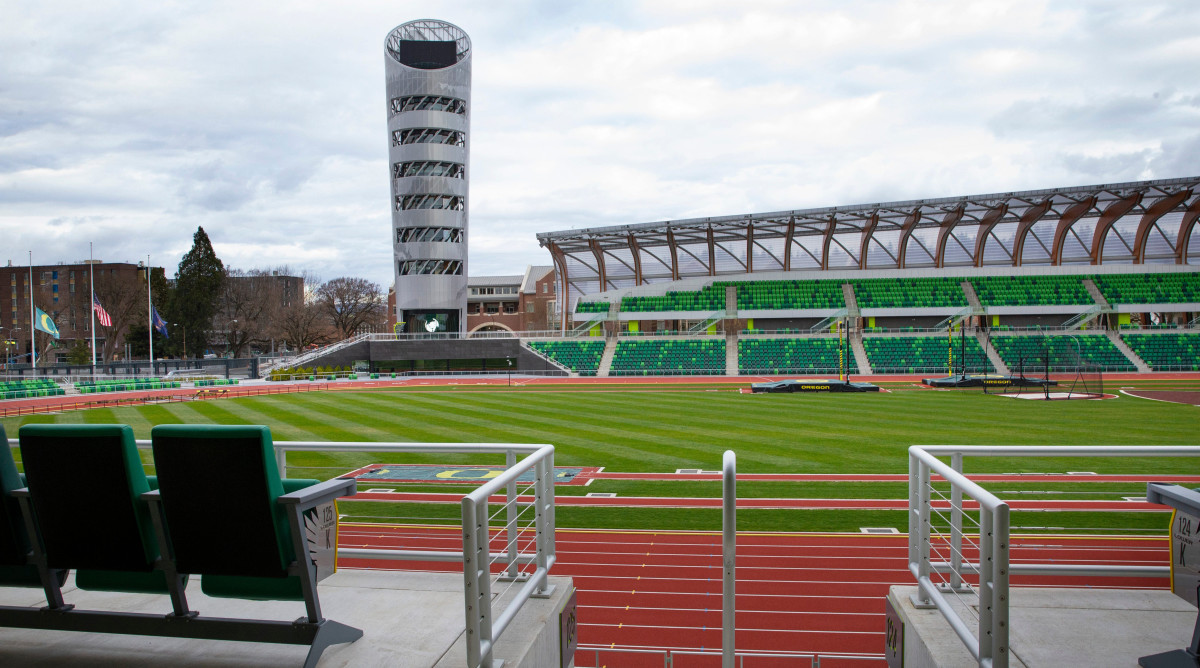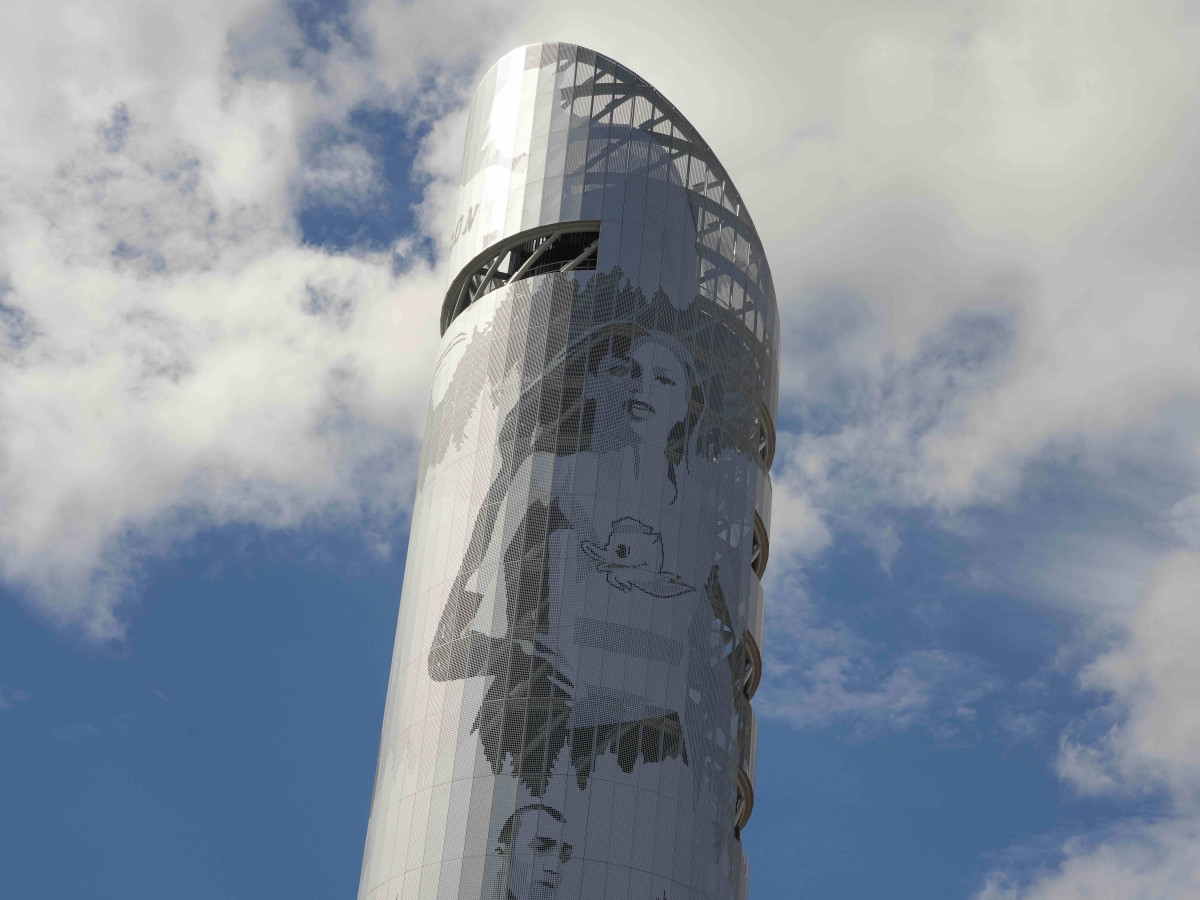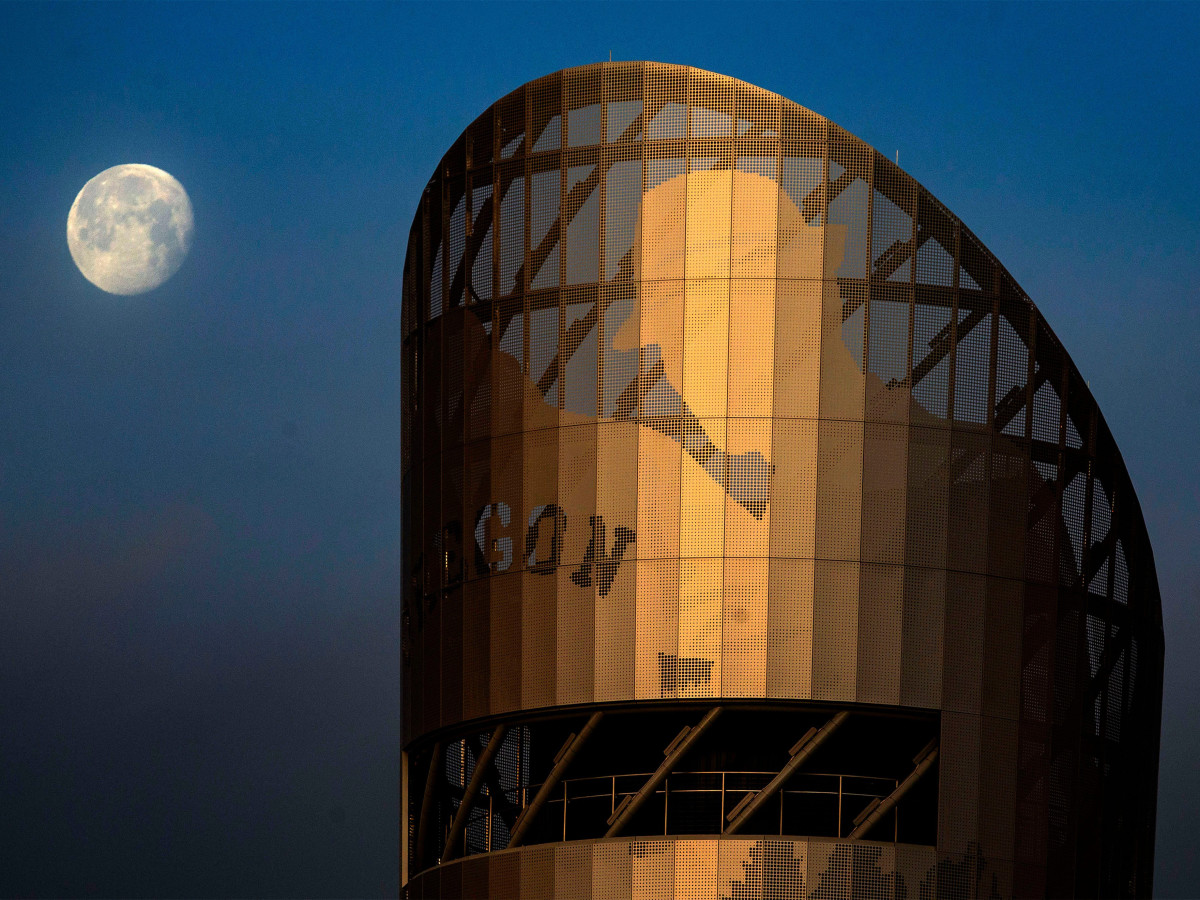The Beautiful Mystique of the Hayward Field Tower


EUGENE, Ore. — This tower, well, it towers. It rises and rises—and rises and rises. It soars skyward, until necks scream from bending back too far. It stands sentry, looming over the frenzy that is a world championships track meet unfolding down below.
This tower, all 10 stories and 188 feet (plus 8 inches) of it, is almost unfathomable. It gleams on sunny afternoons. At night, it can be lit up, like the Empire State Building. It alternately resembles the world’s largest ice cream cone, the world’s tallest and shiniest vase or (more on this later) the world’s largest joint.
This tower seems so out of place. It’s located in, of all places, a college town in the Pacific Northwest, in Eugene, 110 miles south of Portland. It’s perched inside a stadium on Oregon’s campus, a short sprint—or long throw—from three dormitories and the student café Dux Bistro. It’s the second-tallest structure in the city. This isn’t just any stadium, either. It’s Hayward Field, a sport’s cathedral, exclusive to track and field.
This tower, with five icons etched onto its sides, is also historic. That is by design. When Oregon officials most recently remodeled their century-old stadium, they wanted the tower to speak to the history of the track program—100-plus seasons, 22 NCAA titles, four Olympic gold medals garnered by alums.
This tower, officially The Hayward Field Tower, was placed at the corner of 15th and Agate. Designers wanted it at the Hayward entrance—part signpost, part wow factor, part meeting spot, part historical marker.
This tower, THFT, does it all. There’s a lobby with “interpretive” exhibits, whatever that means, offices for Oregon track coaches and an observation deck. There’s an exterior fashioned with “perforated metal skin and steel form,” spiraling upward, the designer’s nod to an Olympic torch. There’s the same exceptional—and exceptionally up-close—view from the east stands. There are viewing areas, elevators, stairways and staircases, meeting rooms and concourses and security stations.
And, after sitting in the newest iteration of Hayward for all 45 minutes Monday, I had an idea that grew, in only 24 hours, into an obsession. I wanted to watch the world track championships from the observation deck. I wanted to capture the view. With no objections from my editors, so began the quest. It was tower time.
I emailed the world championships staff Tuesday morning. No response. Followed up around lunch. Silence. Tried the Oregon track staff. Zilch. The mission would continue. There was no other choice. A bus was boarded; security, navigated; scorching temperatures, endured.
Locating THFT marked the easy part. Thus began a full-scale tower reconnaissance and Day 5 of the first world championships held in the United States. From the standing balcony at the north end of Hayward Field, fans crowded around a railing. Many smiled. Some stood on their toes for a better view. One wore a USA track singlet. All came to admire Sydney McLaughlin, the world-record holder in the 400-meter hurdles, an American from New Jersey with a towering presence of her own. She easily won her heat in 53.95 seconds, but I missed the final stretch, while staring at the tower’s base, thick and gray and round, flanked by two flags.
Time to move closer. Toward the entrance at the base. Near the OR22 sign where groups stood in line for pictures. When they walked away, not a single person looked up. They were missing the Oregon legends displayed on the tower’s sides. There was Ashton Eaton, the decathlete, five-time NCAA champion and two-time Olympic gold medalist. And Otis Davis, who snagged a pair of golds at the Olympics in 1960, while setting world records in both events (400 meters and 4 X 400-meter relay). And Steve Prefontaine, a runner so legendary he needs no introduction. And Bill Bowerman, the distinguished UO coach and Nike cofounder. And someone else who was harder to place.

Turns out, it was Raevyn Rogers, a six-time NCAA champ. Bonus: She is competing here, in the 800-meter dash. Imagine that. Competing against world-class athletes (like budding U.S. star Athing Mu) at your college track stadium, where there’s a 10-story tower with your face on the side. Is there a better flex?
The entrance at the base was guarded by an official in the ubiquitous purple polo shirt worn by everyone working these world championships. He donned sunglasses and AirPods and looked friendly enough. But as I shakily walked toward him, considering what to say, a man and his toddler son got there first. Obvious question: Why didn’t I bring my kid? When they were turned away, it was time to regroup and consider other approaches.
More walking. More neck craning. More bumping into people who were watching where they were going. Up close, THFT was breathtaking in size and scope and steel.
Waiting. Waiting. Waiting. Surely, someone would look skyward and see what seemed so obvious: an architectural marvel, inside a sports stadium, in the most unlikely of places. No one did. Everyone who stopped by THFT—the woman who laid her baby on a blanket, the dozens who filled up bottles at the water station, the tipsy group of college students—appeared to desire only one thing. Shade. This was the tower’s primary function Tuesday evening.
By the time I circled back, the guard was gone. In his place sat three metal barricades hooked together. There was a black folding table with used sanitizing wipes and a package of coloring chalk, an elevator with a javelin thrower painted on its doors and an eerie security camera lurking in the corner that all but begged for onlookers to wonder what might be inside. Phil Knight’s track stadium swimming pool? A closed-door meeting for The Skulls? Still, I tried the door. Locked.
Perhaps there was another entrance. More walking. More neck bends. A wobbly toddler in a Nirvana T-shirt pointed at THFT. Or maybe just the sky. Fans sat on the steps nearby. But rather than look up, they cast their eyes downward, at their phones. Shade remained undefeated.
One level up, on the side of the tower opposite the entrance, the tower went ignored in favor of tallboys, races, water stations and almonds. Until … finally! At the sight of Bowerman, his face painted onto green boards that I’m guessing were from older stadium bleachers, a man wearing an orange polo shirt stopped and took out his cellphone. A tower fan! Surely, he would dispense some wisdom. But after approaching, he asked, “So you want to know about … a tower?” Yes. Oh God, yes. “It’s, um, big.” He walked away.
This was turning into an upset, on a night when upsets reigned on the actual track and actual field. I stumbled upon a hilarious (and fictional) story from Eugene Weekly that jokingly posited that the “Hayward Joint” would bring the campus together and “help students save on weed money so they can pay tuition.” It even quoted “someone” from Oregon’s “Cannabis Studies Program;” a Professor Kush.
Tried a cop next. He looked friendly, right until he shook his head. No way.
“Maybe you want to find a different story.”
“You sound like my editors.”
Tried the “Info” desk after that. Also kind. Also no.
Checked the merchandise stand. No tower T-shirts in sight. No toy towers. No tower statues.
Attempted to convince two younger purple-shirters working in the ticket office to take me up for a quick glance. No way, dude. I might get fired.
While making the sad-trombone walk back to the media tribune, past the man wearing the Anti-Racism Running Club T-shirt, the dozens buying “10-inch pretzels” and the longest snow cone line in the history of snow cone lines, the solution crystallized. Write the big events of Tuesday and live to quest another day. But those results weren’t what anyone expected, either.

U.S. sprinter Fred Kerley, fresh off his 100-meter dash triumph last week, finished sixth in his 200-meter semifinal. Afterward, he blamed a hamstring cramp. Noah Lyles and Erriyon Knighton did advance to Thursday’s final, perhaps the most intriguing race remaining.
Meanwhile, a 28-year-old from Great Britain whose highest previous world championships finish was fifth won the 1,500-meter run. Yes, Jake Wightman topped Jakob Ingebrigtsen, the Norwegian favorite who had already won an Olympic gold medal and ran the fastest indoor 1,500 by age 21. Ingebrigtsen had boasted he would “for sure” double in the 1,500 and 5,000 here. A towering performance, his was not.
Perhaps Rai Benjamin, the U.S. 400-meter hurdles finalist, would save the day. Or, at least, tussle once again with his rival, Karsten Warholm of Norway. The duo engaged in one of the most fascinating races in Tokyo. Both set world records. Warholm just ran a smidge faster. And Benjamin did finish ahead of Warholm on Tuesday. But he did not finish first, netting another silver, behind Alison dos Santos of Brazil and ahead of teammate Trevor Bassitt, who snagged the bronze.
THFT loomed throughout, serving, perhaps, as a reminder of how much track matters here, in this city and this stadium and even on this night. Not only is there a tower inside a track stadium, but that tower, as tall and without peer as it is, was never the main attraction. It was, simply, another small—and yet tall—part of the draw.
More World Championships Coverage:
• Eugene Is an Obvious—Yet Unlikely—First U.S. Host of the World Championships
• United States Sweeps Men’s 100 at World Championships
• Allyson Felix Nabs Bronze in Her Farewell Race
